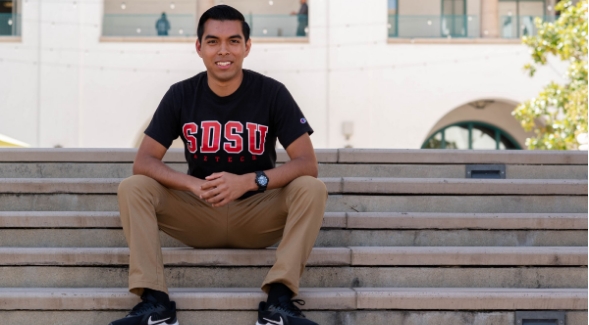Did It in Three: Matthew Martinez's Sprint to Graduation
Matthew Martinez, an SDSU public health major, is graduating in three years, an impressive feat against the backdrop of the pandemic.

In less than a month, Matthew Martinez will be completing an impressive feat as one of more than 10,000 San Diego State University students to receive their bachelor’s degrees.
The Long Beach native and first-generation college student is graduating summa cum laude with a degree in public health — accomplished in just three years.
Martinez — who wanted to graduate early to save money and get closer to working in his intended field — said despite the pandemic shift to remote studies, he had a full college experience that set him up for future success.
This year alone, he worked at the Center for Intercultural Relations (CIR) as a peer mentor for the Young Men of Color Alliance program, represented SDSU at the California State University system’s Young Men of Color Consortium Conference in Sacramento, and interned with the California Department of Public Health’s COVID-19 clinical response team.
Previously, Martinez served with AmeriCorps working at a Los Angeles community vaccination site.
“I’ve really enjoyed my time at SDSU and have found it to be extremely rewarding,” said Martinez, who will attend UCLA’s graduate program in public health in the fall toward a career goal of helping underserved communities prepare and recover from disasters.
“It has been tough, especially with COVID, and took a lot of adapting because each year on campus was a completely different experience from the previous one, but I’ve enjoyed it nonetheless.”
Martinez’s ahead-of-schedule graduation comes at a time when the entire CSU system has been working to reach the goals of its Graduation Initiative 2025: to increase graduation rates, eliminate equity gaps in degree completion and meet California’s workforce needs.
One of the initiative’s goals is to improve four-year graduation rates from 19% in 2015 to 40% by 2025. In 2021, statewide rates were on track to meet the goal, rising to 33%.
SDSU has implemented several resources to improve time-to-degree, with nearly 57% percent of students graduating in four years in the most recent graduating class — exceeding the 54% campus goal four years early. And first-generation student four-year rates have improved, from 28% for those who arrived in fall 2013 to nearly half (48.6%) of the fall 2016 cohort.
“We are very proud of Matthew and students like Matthew who are utilizing university resources and support services to graduate early,” said Randall Timm, associate vice president for Campus Life and Dean of Students.
Summer sessions and the “supportive scaffolding” of advising, tutoring, mentoring and career planning, Timm said, “help keep students stay on track and, if they go off track, we provide connection to people who are there to help students rebound successfully.”
Martinez credits his rapid degree completion to several of these: using all of the resources available to plan and map out his degree coursework, including the MyMap and Degree Evaluation tools; taking summer session courses each year; and regular meetings with his academic and major advisers, identifying individual courses that satisfy multiple degree requirements.
Careful selection helped keep him engaged with a heavy course load. “You have to find ways to keep the will and drive going, and one way you do it is to not sign up for boring classes,” Martinez said.
Martinez got a head start on his road to his degree by entering school with sophomore standing due to advanced placement course credits from high school. He then took 17 units in his first semester in fall 2019, 16 units during spring 2020 and was “feeling in the groove” of school when students were sent home in March 2020 at the outset of COVID-19.
“It was an exciting time socially, I was getting used to campus and enjoying college work, and then we went home,” Martinez said.
“Fortunately, our professors were super transparent because they knew that making all items virtual would take time to adjust, they gave us grace periods to turn in assignments at different times,” he said. “It required some adjusting but two or three weeks into it, we got right back on track.”
Martinez said he was excited to return to campus for his final year.
“Coming back to SDSU, there was a disconnect in the community and students wanted to find a way to meet with students and meet people,” he said. “My role with CIR definitely helped me build my community on campus.”
CIR Executive Director Paige Hernandez has known Martinez since his first year and was impressed by his focus and willingness to ask for support from staff. When students returned to campus, Hernandez said it was a no-brainer to ask Martinez to join the staff.
“He really has been the navigator of his own success these past three years,” Hernandez said. “And I’ve always been impressed with his ability to find resources not just for himself, but for other students of color as well. I think Matthew has created a space and environment where his mentees feel validated and have a safe space to share their experiences as men of color. He’s created authentic, powerful relationships.”
Martinez’s advice to incoming first-year students who want to complete their degrees on time or ahead of schedule?
“Doing as many different things as you can to figure out your ‘why,’” Martinez said. “What has helped me with keeping the motivation and drive to do all of these activities is because these are not things I have to do, these are things I am excited to do.”
“There’s a great experience at SDSU for everyone who attends,” he added. “You just have to find it.”



